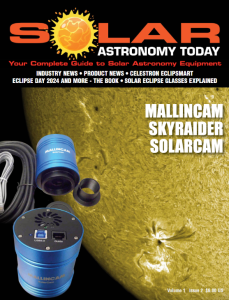The Sky-Watcher 25th Anniversary SkyMax 127 Virtuoso GTi is a limited-edition offering housed in a sleek, commemorative design. It offers a premium Sky-Watcher SkyMax reflector telescope that offers crisp, aberration-free views. The 127mm Maksutov-Cassegrain design captures in-depth detail of planets, nebulae, galaxies, the rings of Saturn, Jupiter’s Great Red Spot and Galilean moons, as well as craters and mountain ranges on the Moon.
 The Sky-Watcher team notes, “As we celebrate our 25th anniversary, we are incredibly proud of the contributions we have made to the world of astronomy. We are grateful to our loyal customers who have supported us over the years, and we look forward to continuing to provide you with the best possible telescopes, mounts, and accessories for many years to come. The 25th Anniversary SkyMax 127 Virtuoso GTi is a tabletop telescope that isn’t just a powerful instrument; it’s a collector’s item, a tribute to innovation, and your gateway to celestial wonders.”
The Sky-Watcher team notes, “As we celebrate our 25th anniversary, we are incredibly proud of the contributions we have made to the world of astronomy. We are grateful to our loyal customers who have supported us over the years, and we look forward to continuing to provide you with the best possible telescopes, mounts, and accessories for many years to come. The 25th Anniversary SkyMax 127 Virtuoso GTi is a tabletop telescope that isn’t just a powerful instrument; it’s a collector’s item, a tribute to innovation, and your gateway to celestial wonders.”
The 25th Anniversary Virtuoso GTi mount easily navigates the night sky, automatically slewing to over 10,000 celestial marvels with the free Sky-Watcher SynScan app that also features user-friendly tours and information (42,000+ objects with the optional hand controller). Plus, with Sky-Watcher’s patented Freedom-Find technology, the user can unlock the clutch and adjust the mount manually without losing their alignment. The optical tube features a Vixen-style dovetail which can be attached to most standard astronomy mounts and the base can be attached to a standard photographic tripod for multiple configurations.
The Sky-Watcher 25th Anniversary SkyMax 127 Virtuoso GTi specifications include:
Optical Specifications
– Optical Design: Maksutov-Cassegrain
– Mirror Coating: Sky-Watcher RAQ Coatings
– Reflectivity: 94%
– Mirror Type: Conical
– Glass Type: Borosilicate
– Primary Aperture: mm
– F/Ratio: 12.1
– Focal Length: 1540mm
– Secondary Diameter (minor axis): 39mm
– Secondary Obstruction by Diameter: 31%
– Secondary Obstruction by Area: 9%
– Primary cell support: Center Baffle
– Optical Quality: Diffraction limited (1/4 wave)
– Collimatable Cell: Primary
Mechanical Specifications
– Focuser Type: Primary
– Focuser Size: 2″
– Focuser: Dual or Single Speed: Single
– Optical Tube length: 15″
– Optical Tube weight (with accessories): 10 pounds
– Type of bearing used: Roller
– Tripod Mount: 3/8 thread block
– Assembled base weight: 11 pounds
– Total Weight (with accessories): 21 pounds
– Shipping Weight: 28 pounds
– Shipping Dimensions Box 1: 23″x17″x16.5″
Electronic Specifications
– Required Power: 12v/AAs (8x)
– Power port diameter: 2.1mm
– Freedom Find: Yes
– Clutch Type: Hand Clutch
– Can clutches be adjusted: Yes
– Built-in Wi-Fi: Yes
– Hand Controller: Optional
– Database: Complete Messier, Caldwell, NGC, IC and SAO catalogs, user defined objects. Total 10,000+ objects
Accessories
– Eyepieces:28 mm 2″ LET eyepiece
– Finder: 9×50 optical finder
– Mounting: V-style dovetail
Observational Info
– Dawes Limit: 0.91
– Rayleigh Limit: 1.1
– Limiting Magnitude: 13
– Minimum Magnification: 18x
– Maximum Magnification: 250x
– Magnification with included eyepieces55x (: 28mm)
– Intended use: Visual
You can learn more about the Sky-Watcher 25th Anniversary SkyMax 127 Virtuoso GTi here.

 And to make it easier for you to get the most extensive news, articles and reviews that are only available in the magazine pages of Astronomy Technology Today, we are offering a 1-year magazine subscription for only $6! Or, for an even better deal, we are offering 2 years for only $9. Click here to get these deals which only will be available for a very limited time. You can also check out a free sample issue here.
And to make it easier for you to get the most extensive news, articles and reviews that are only available in the magazine pages of Astronomy Technology Today, we are offering a 1-year magazine subscription for only $6! Or, for an even better deal, we are offering 2 years for only $9. Click here to get these deals which only will be available for a very limited time. You can also check out a free sample issue here.
The Sun is more active than it’s been in years and if that’s not enough, we have the upcoming Total Solar Eclipse on April 8, 2024! If you’d like to learn more about the technology behind solar observing, solar imaging and more, you can check out our new monthly magazine – Solar Astronomy Today. It’s free to read, no subscription needed and available here. And if you are preparing for the upcoming eclipses and want to know your equipment options from solar glasses to the most out of this world solar viewing and imaging options, check out our free publication – The Definitive Guide to Viewing and Imaging the Sun – simply click here and enjoy reading!

